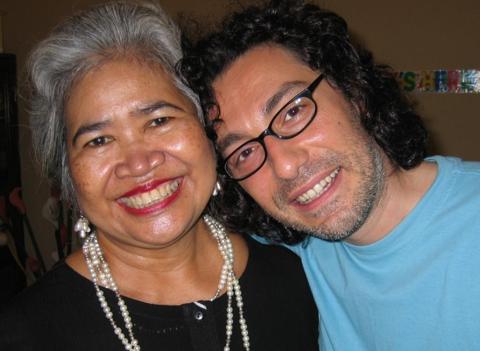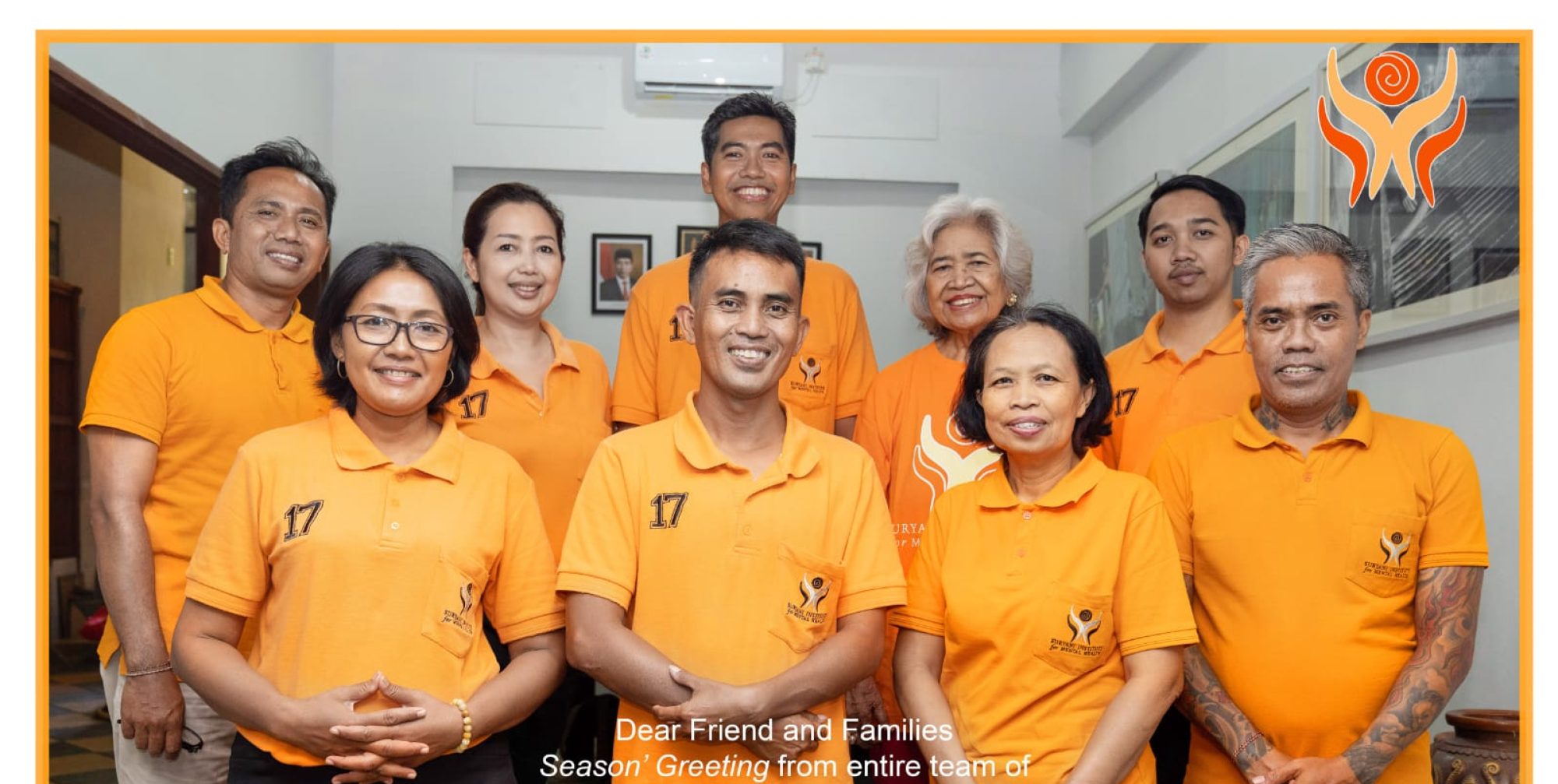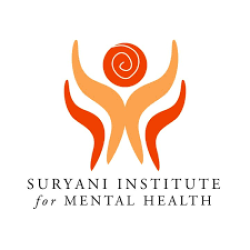On the first dawn of 2009 I find myself having breakfast with Professor Luh Ketut Suryani, at her family compound in Denpasar, Bali. She has stayed up all night to welcome the new sun through an impromptu group-meditation session at Sanur beach. Yet, unlike me, she is full of positive energy, with her 65 year-old-eyes radiating the morning’s tropical warmth, in majesty and elegance.
“I feel blessed!”, I finally gather the courage to admit to her. “I feel blessed, because yesterday night I witnessed the birth of a new religion.”
She smiles at me. The Professor – although a prolific writer, with over 100 articles and books under her pen – never talks a lot. Yet each word she summons comes straight from the spiritual kaleidoscope of her soul.
“I only ask them to follow their dreams.” she replies, and her words vibrate the coffee in my hands.
Follow their dreams… Follow their dreams…
Just like she had done; just like she always does.

Fourth-born to a family of the lowest Balinese Hindu caste, she is now the most influential woman in the fifth largest country in the world. She has fought prejudice, sexism, religious discrimination, tradition, societal intolerance, political prosecution, and, against impossible odds, she has triumphed. She is now a high member of the royal family of Klungkung by marriage, a spiritual leader, an outspoken politician, and a Professor of psychiatry. The Queen of Bali; the Balinese Healer; the Indonesian Mother. And she has only followed her dreams.
“The past belongs to our ancestors”, she taught me once, “The future belongs to our Supreme God; it’s the present that belongs to us. Yet, we seem to be spending most of our lives in past thoughts and future tenses.”
On this New Year’s morning, however, I cannot help but think of the day ahead. For the Professor, it is just another day, with her secretaries frantically trying to organise her always overbooked schedule: 9:00 am, newspaper interview about her views on the upcoming national elections; 9:20 am, meeting with local psychiatrists to coordinate action on mental health issues; 10:30 am, gather psychiatric evidence to help with the prosecution of a recently arrested Australian paedophile; 12:00 pm, meeting with the governor to discuss her mental health proposal; 2:00 pm, public lecture on psychopathy; 3:30-7:00 pm, appointments with her patients; 7:30 pm, radio interview on suicide; 9:00 pm, TV interview on family planning; 10:30 pm, formal dinner with community elders. Still, among this overflow of engagements, she always finds time to spend with her family and play with her grandchildren, time to pray, meditate, or participate in religious ceremonies. It seems that my whole life is in a day’s work for the Professor!
I walk with her to the Suryani Institute for Mental Health (SIMH), an institute she has founded to help people with mental illnesses, through treatment, education, and community-based prevention projects. The Spiritual-Hypnosis Assisted Therapy (SHAT), she has developed through her clinical experience, has been attracting patients from all over the world, and I would often find myself talking to an American or a European, who had flown to Bali just to be treated by the Professor. Westerners pay a premium for her sessions, but it is money most needed. She uses it to fund her free public lectures, seminars, and family training programs, to provide free medication and treatment where necessary, to finance her various research projects, and to pay her numerous field-workers, who constantly scout the island to identify individuals who are in need for mental health treatment.
“I care about my people.” she confesses to the wind as we walk by street-sellers, bystanders, and pedestrians, all of whom bow on her sight. “We are a tiny island-culture on the verge of extinction. I cannot sit back and do nothing about it.”
The island of Bali! One of the very few remaining cultural jewels on earth. A culture so rich with spirituality and legend, one can feel the Devas dancing in the moonlit rice-paddies; so colourful and playful, it reminds me of my kindergarten years. A culture so innocent it attracts evil. The paedophile’s paradise; the drug-dealer’s playground; the pimp’s slave-market; the Westerner’s bordello! A few years ago, I was dining with the Professor at one of her favourite seafood taverns in Jimbaran, just days before it was blown up by terrorists. Professor Suryani and her team of medical doctors and psychiatrists were actively involved with providing emergency medical treatment and psychotherapy to the victims of both the 2002 and 2005 terrorist attacks on the island.
She cares about her people; I know she does… the Balinese know it as they bow in respect… the wind knows it now too…
We arrive at the institute. The place is busting with activity. Mahatma Gandhi’s smiling bust features prominently in the waiting room. Next to it the newspaper journalist is already waiting for his appointment. The Professor greets him; since my Indonesian is worse than my mental health, I leave them and go upstairs to face my own commitments for the day.
In an office, sitting in front of a computer, Dr Cokorda Bagus Jaya Lesmana waves impatiently at me to join him. Dr Lesmana is one of the Professor’s six sons, a psychiatrist himself, and a university lecturer. Among his responsibilities at the institute is to coordinate with the field-workers with surveying Bali for unreported and consequently untreated mentally ill people. He has just identified some new cases and he is eager to show me the pictures he had shot. I sit next to him and witness the terror of inhumanity unfold on the monitor:
A seriously malnourished man is chained to a tree; another one, is lying naked over his own faeces and urine, with one of his legs locked between two tree-trunks; a young woman in a foetal position inside a cage no larger than a dog’s kennel… And on and on the pictures come, like stills from a horror movie… and on and on the scarred faces reveal stories of unspeakable pain and despair… dozens… hundreds of them.
Dr Lesmana comments on every picture with an obvious but professionally contained shock. “This man has been in chains for ten years; we diagnosed him with chronic schizophrenia; this one has been like this for almost 20 years; schizoaffective; this woman has been locked in this tiny cage for over 15 years, can you believe it? Severe schizophrenia.”
Professor Suryani and her team have already surveyed almost half a million individuals – a seventh of the Balinese population – and have identified about a thousand such cases. People like the above; people who for legal, social, cultural, or educational reasons have been condemned to a life of torture, to live a nightmare worse than any death. People who some years ago used to be like me and you… “This one was a professional athlete; this one was an electrical engineer; this one a farmer…”. Now, they don’t exist; they have been banished from life; forgotten… forsaken.
“This is not just a mental health problem anymore.” I finally state, “It is clearly a human rights issue! We must inform Amnesty International.”
Dr Lesmana looks at me with a sad face that says “What makes you think they will care?”
“They must care”, I shout in frustration as I notice his 2-year old son calling me from the distance – “Om Niko… Om Niko…” – and in his voice I realise I had already tried to contact Amnesty International, the BBC, the ABC and other such organisations in vain. “They must care.” I whisper…
At least the Indonesian government was finally forced to care, in part due to the outcry a short documentary – Dr Lesmana and I have made about all this – has generated after being posted on YouTube and other online media services. They have pledged approximately $150,000 AU pa to this project. With this money the institute can treat just over 300 individuals annually. Although there are potentially thousands more that will have to be left untreated, we still consider it a celebratory success. Before this issue became public, the Indonesian government officially declared that mental illness in Bali was almost nonexistent. Not surprisingly then, there are only 20 psychotherapists on the island, even fewer than just those currently working at the University of Sydney! We spend the rest of the morning distributing the budget and discussing how to prioritise treatments.
…
It is late afternoon already, and as Professor Suryani is returning to the institute to begin her therapy sessions, Dr Lesmana and I are driving across Denpasar to meet with the new field-work recruits. They are undergraduate medical students from Udayana university who will be conducting the first part of the mental health survey in Denpasar. Given the resources and time available, they will have under a week to interview approximately 120,000 individuals! A colossal undertaking indeed that requires careful planning and precise execution. Dr Lesmana’s task today is to explain to them the concepts behind the clinical or otherwise assessments they will be using and to show them how to record and code responses. My role is to guide them through the procedural idiosyncrasies of conducting a medical survey and field interviews and to indicate possible problems they may encounter and ways to overcome them.
At one point during our meeting one of the students asks:
“I don’t see the benefit in all this. You are mobilising all these resources and personnel for a job that we already know will be incomplete. Why are we bothering?”
“Good question!” I reply. “However, if through this otherwise incomplete process we manage… you manage to identify even a single individual that is in an immediate need for psychiatric care, we will have saved, you will have saved a soul from a life-sentence in living hell. And that is what makes all this worth doing!”. And so the next day they went on and conducted their incomplete survey, through which almost 200 people were identified with untreated serious mental health problems. Two hundred lost souls now have the chance of being delivered from their hell. A job well-done even by that student’s standards!
On our way back to the institute, Professor Suryani’s voice is keeping us company as she is debating her ideas on the radio. In one of her ongoing projects she is trying to understand the causes of the sharp rise in suicide incidents on the island. Her primary suspect is the observed breakdown in communication within families. However, what may have caused this condition in the recent years remains elusive: The influx of Westerners with their low tourist morality? The increasing presence of Muslim and Christian communities on the island with their alien moralities? The serious economic crisis that followed the terrorist attacks that defy any morality? Nobody knows yet, but the Professor is determined to find out and develop strategies and interventions to eradicate this menace from her people.
Back at the institute we are greeted by a man in his forties, one of those identified cases, diagnosed by the team with chronic schizophrenia and contracture caused by chronic Guillain-Barré syndrome. He had been literally carried there by members of his family, as he was suffering from severe paralysis of his extremities, in part because he had been in chains for the past seven years. Through a series of successful interventions, Professor Suryani has managed to bring him back to a functional state, and subsequently to secure money to buy him a laptop to help exercise his fingers and catch up with the seven-year gap he has from the world. Dr Lesmana and I show him how to use it and explain why he should try utilising all his fingers when typing. He cannot contain his gratitude. His face is shinning with surprise, optimism, and joy. His days in hell are over. He can now start living again. I am overwhelmed by intense emotions and have to excuse myself. I move to another room, where the Professor is negotiating on TV her family planning ideas with verve and a calm wisdom. I look at her; I look through her; I can see all these people around her; these ill-fated, tormented souls looking up to her, reaching to her, asking for her pity. They know she is the only one who can help them; they know she is the only one who truly cares. “Thank you” is all I can say.
…
On the first night of 2009 I, once again, find myself sitting next to Professor Suryani. A very intense day for me; just another day for the Professor; an honestly rewarding day for both of us. She is stirring her tea, I am sipping my Bintang beer, we are both too tired in our thoughts. Suddenly, she speaks:
“If it helps people be happy and make happy the people around them, I welcome it.”
“Excuse me?”
“The birth of that new religion, you mentioned in the morning…”
She sends me a kind smile and then she follows it to her night meditation session. As she vanishes in the shadows I sink back into my beer-thoughts. How do I make sense of this unfolding tragedy? How do I communicate Professor Suryani’s and her team’s brave, sincere, and herculean efforts? How do I tell the story of these people to someone as far detached from it as you are?
Let me tell you about a day in their life…

